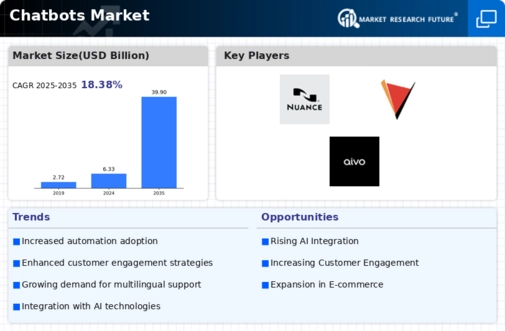Market Share
Introduction: Navigating the Competitive Landscape of Chatbots
The chatbot market is experiencing an unprecedented level of competition, mainly because of the speed of technological development, the evolution of regulatory frameworks, and the growing expectations of consumers for a more personal and more efficient inter-action. The major players in this market are the original equipment manufacturers, IT system integrators, suppliers of infrastructure, and a few artificial intelligence (AI) companies with a wide range of strategies. The original equipment manufacturers are integrating advanced AI-based analytic and automation capabilities into their products, while IT system integrators are focusing on easy deployment and customisation to enhance the end-user experience. The small, mainly start-up, AI companies are pushing the boundaries of technological development, integrating the Internet of Things and biometrics into their solutions and setting new standards for engagement and efficiency. As companies become more and more interested in green IT, the question of the degree of sustainability of their solutions becomes a key differentiating factor. The North American and Asian Pacific regions offer the most significant growth opportunities, as strategic deployment trends coincide with local market needs. The agile players who are able to take advantage of this evolving landscape will enjoy significant growth opportunities through 2024 and beyond.
Competitive Positioning
Full-Suite Integrators
These vendors offer comprehensive solutions that integrate various functionalities of chatbot technology, catering to diverse business needs.
| Vendor | Competitive Edge | Solution Focus | Regional Focus |
|---|---|---|---|
| IBM Corporation | Robust AI capabilities and enterprise integration | AI-driven chatbots and automation | Global |
| Nuance Communications Inc | Advanced natural language processing | Conversational AI and customer engagement | North America, Europe |
Specialized Technology Vendors
These vendors focus on niche chatbot technologies, providing specialized solutions tailored to specific industries or use cases.
| Vendor | Competitive Edge | Solution Focus | Regional Focus |
|---|---|---|---|
| Inbenta Technologies Inc | Strong focus on semantic search and knowledge management | Knowledge-based chatbots | Europe, North America |
| Next IT Corp | Customizable solutions for various sectors | Virtual assistants and chatbots | North America |
| Acuvate | Expertise in Microsoft ecosystem integration | AI chatbots for enterprises | Global |
| Aivo | Real-time customer service automation | Customer support chatbots | Latin America, Europe |
| Artificial Solutions | Natural language understanding expertise | Conversational AI platforms | Global |
Infrastructure & Equipment Providers
These vendors provide the underlying technology and infrastructure necessary for deploying chatbot solutions effectively.
| Vendor | Competitive Edge | Solution Focus | Regional Focus |
|---|---|---|---|
| eGain Corporation | Omnichannel customer engagement solutions | Customer engagement and support | North America, Europe |
| Creative Virtual Ltd | Focus on virtual agents and knowledge management | Virtual agent solutions | Global |
Emerging Players & Regional Champions
- AI-powered chatbots for e-commerce: Chatbotify (US): Specializes in chatbots for e-commerce platforms, and has recently teamed up with a major retail chain to enhance their online customer support. It competes with established vendors by offering a more flexible solution.
- Conversational AI Solutions (India): Focuses on multilingual chatbots for the Indian market, recently implemented a chatbot for a leading telecom provider, complementing established vendors by filling the gap in regional language support.
- BotCraft (Germany): Offers industry-specific chatbots for healthcare and finance, recently secured contracts with several hospitals for patient engagement, positioning itself as a challenger to larger players by providing tailored solutions.
- Dialogflow Innovations (Brazil): Develops chatbots for small and medium enterprises, recently launched a platform that integrates with local payment systems, complementing established vendors by targeting underserved market segments.
- AI Chat Solutions (South Africa): Focuses on chatbots for the tourism sector, recently partnered with a national tourism board to enhance visitor engagement, challenging established vendors by offering localized content and support.
Regional Trends: The use of chatbots is growing in emerging markets, particularly in Asia and Africa, driven by the need for cost-effective customer service. The technological specialization is redirected towards multilingual capabilities and industry-related applications. The objective is to increase customer engagement and experience.
Collaborations & M&A Movements
- The partnership between Salesforce and OpenAI is to integrate the advanced AI technology into the Salesforce platform, so as to improve customer service and optimize sales, and further strengthen the competitiveness of Salesforce in the CRM market.
- Google acquired chatbot development firm Dialogflow in 2024 to bolster its AI and machine learning offerings, positioning itself as a leader in the chatbot market and expanding its share against competitors like Microsoft and Amazon.
- The two companies will integrate their respective platforms, and the combination of the two will lead to a significant increase in their market share in the enterprise market.
Competitive Summary Table
| Capability | Leading Players | Remarks |
|---|---|---|
| Natural Language Processing (NLP) | Google, IBM Watson | Google's Dialogflow offers advanced NLP capabilities, enabling seamless user interactions. IBM Watson's NLP is known for its contextual understanding, demonstrated in customer service applications across various industries. |
| Integration with Messaging Platforms | Microsoft, Salesforce | Microsoft's Bot Framework allows easy integration with platforms like Teams and Skype, enhancing user reach. Salesforce's Einstein Bots integrate directly with CRM systems, improving customer engagement and support. |
| AI-Powered Analytics | Zendesk, LivePerson | Zendesk's AI analytics provide insights into customer interactions, helping businesses optimize their chatbot performance. LivePerson's analytics tools enable real-time monitoring and adjustments based on user behavior. |
| Multilingual Support | Amazon Lex, Rasa | Amazon Lex supports multiple languages, making it suitable for global applications. Rasa's open-source framework allows developers to customize multilingual capabilities, as seen in various international deployments. |
| Voice Recognition | Nuance, Google | Nuance's voice recognition technology is widely used in healthcare chatbots, providing accurate transcriptions. Google Assistant's voice capabilities are integrated into various chatbots, enhancing user experience through voice interactions. |
| User Personalization | Intercom, Drift | Intercom's chatbots utilize user data to personalize interactions, improving customer satisfaction. Drift's AI-driven chatbots adapt conversations based on user behavior, leading to higher conversion rates. |
Conclusion: Navigating the Chatbots Market Landscape
By 2025, the chatbots market will be characterized by intense competition and a high degree of fragmentation, with a mix of established players and newcomers. The regional trends show an increasing penetration of chatbots in North America and Asia-Pacific, driven by the development of automation and artificial intelligence. In order to remain competitive, vendors must strategically position themselves in terms of AI-based personalization, automation, and sustainable practices. The established players are concentrating on enhancing their existing solutions, while the newcomers are developing flexible, scalable, and bespoke offerings to meet the diverse needs of customers. Ultimately, the ability to integrate advanced AI features, ensure flexibility in operations, and commit to sustainable practices will be the main criteria for success in this rapidly evolving market.

















Leave a Comment